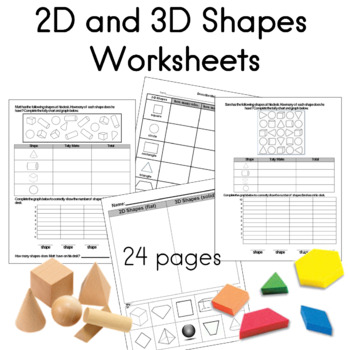2D and 3D Shapes Worksheets
Sailing Through the Common Core
703 Followers
Grade Levels
K - 2nd
Subjects
Resource Type
Standards
CCSSK.G.A.1
CCSSK.G.A.2
CCSSK.G.A.3
CCSSK.G.B.4
CCSSK.G.B.5
Formats Included
- PDF
Pages
24 pages
Sailing Through the Common Core
703 Followers
Also included in
- Shapes 2D and 3D for FIRST GRADE Math, worksheets, task cards, PowerPoint presentations. Get your document camera ready and you are all set for introducing shapes. Use the worksheets and task cards for practice or assessment.Price $7.00Original Price $8.50Save $1.50
Description
Properties of 3-D Shapes 3 pages, Math for kindergarten, first grade, second grade
- Rolls, Slides, Stacks
- number of faces, edges, vertices
- Draw everyday objects that look like each shape
- Count and graph 3D shapes, 2 pages
Properties of 2-D Shapes 5 pages, Math for kindergarten, first grade, second grade
- number of corners and sides
- cut and sort pictures by less than 3 angles 3 angels more than 3 angles
- cut and sort pictures by less than 3 sides 3 sides more than 3 sides
- sort shapes by the number of angles and graph it
- sort shapes by the number of sides and graph it
- Create a picture and record the shapes used
Sort shapes by 2D and 3D
Assessment Included
CHECK OUT 3 Dimensional Shapes Presentation Prek - 1st Grade
Total Pages
24 pages
Answer Key
N/A
Teaching Duration
N/A
Report this resource to TPT
Reported resources will be reviewed by our team. Report this resource to let us know if this resource violates TPT’s content guidelines.
Standards
to see state-specific standards (only available in the US).
CCSSK.G.A.1
Describe objects in the environment using names of shapes, and describe the relative positions of these objects using terms such as above, below, beside, in front of, behind, and next to.
CCSSK.G.A.2
Correctly name shapes regardless of their orientations or overall size.
CCSSK.G.A.3
Identify shapes as two-dimensional (lying in a plane, “flat”) or three-dimensional (“solid”).
CCSSK.G.B.4
Analyze and compare two- and three-dimensional shapes, in different sizes and orientations, using informal language to describe their similarities, differences, parts (e.g., number of sides and vertices/“corners”) and other attributes (e.g., having sides of equal length).
CCSSK.G.B.5
Model shapes in the world by building shapes from components (e.g., sticks and clay balls) and drawing shapes.






